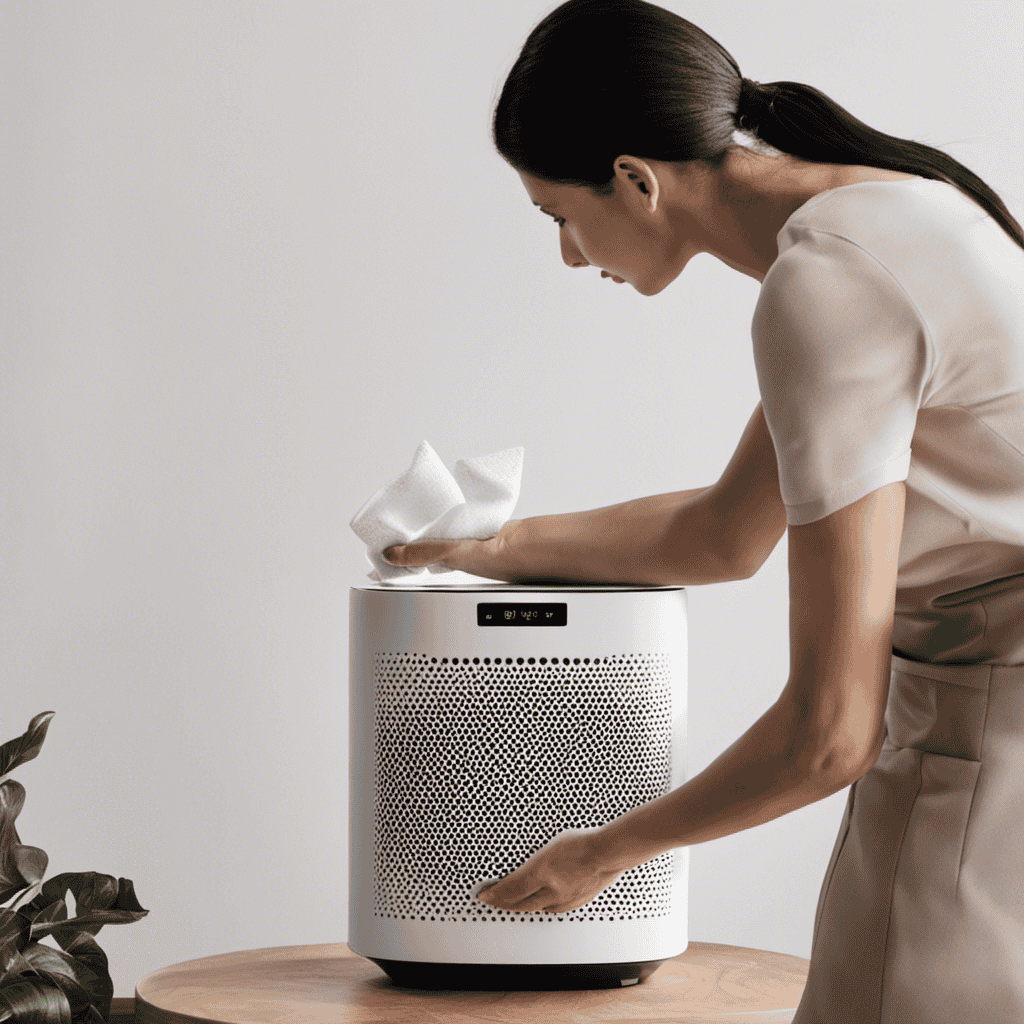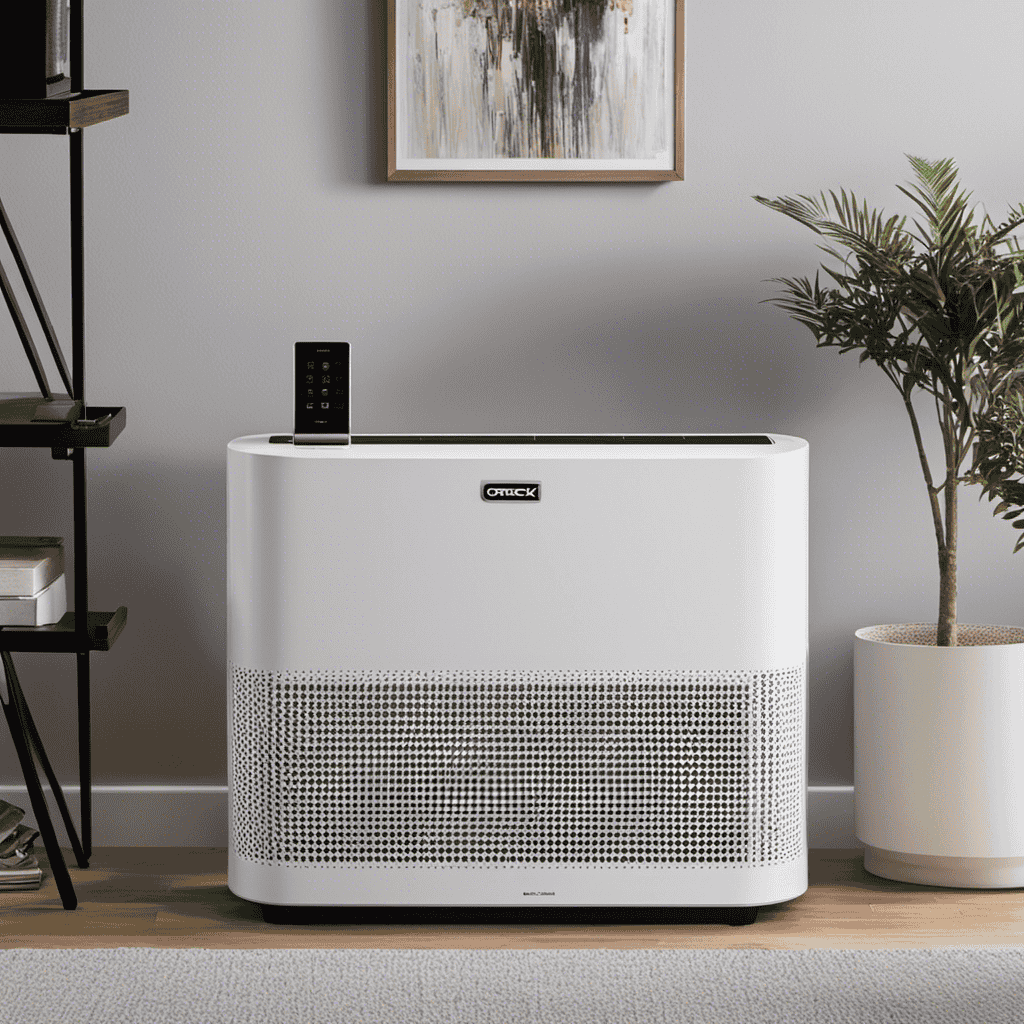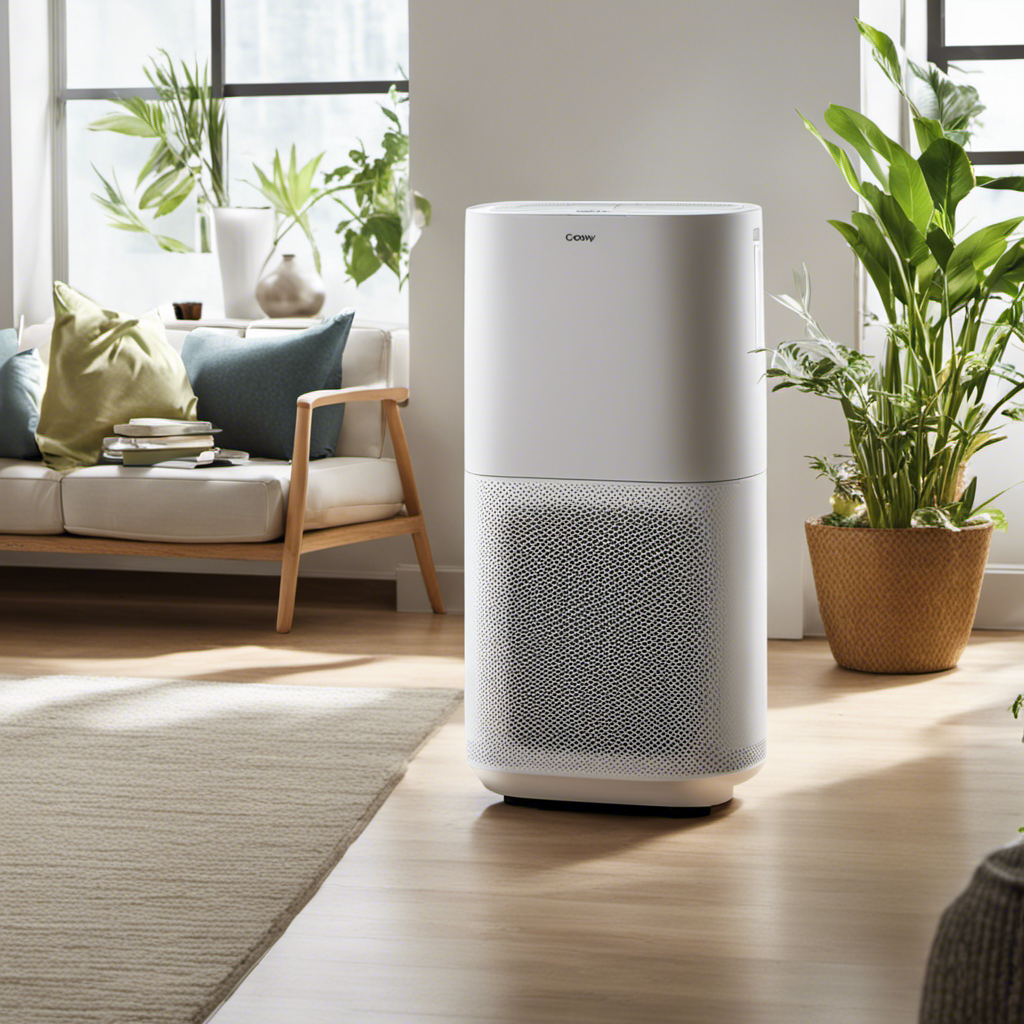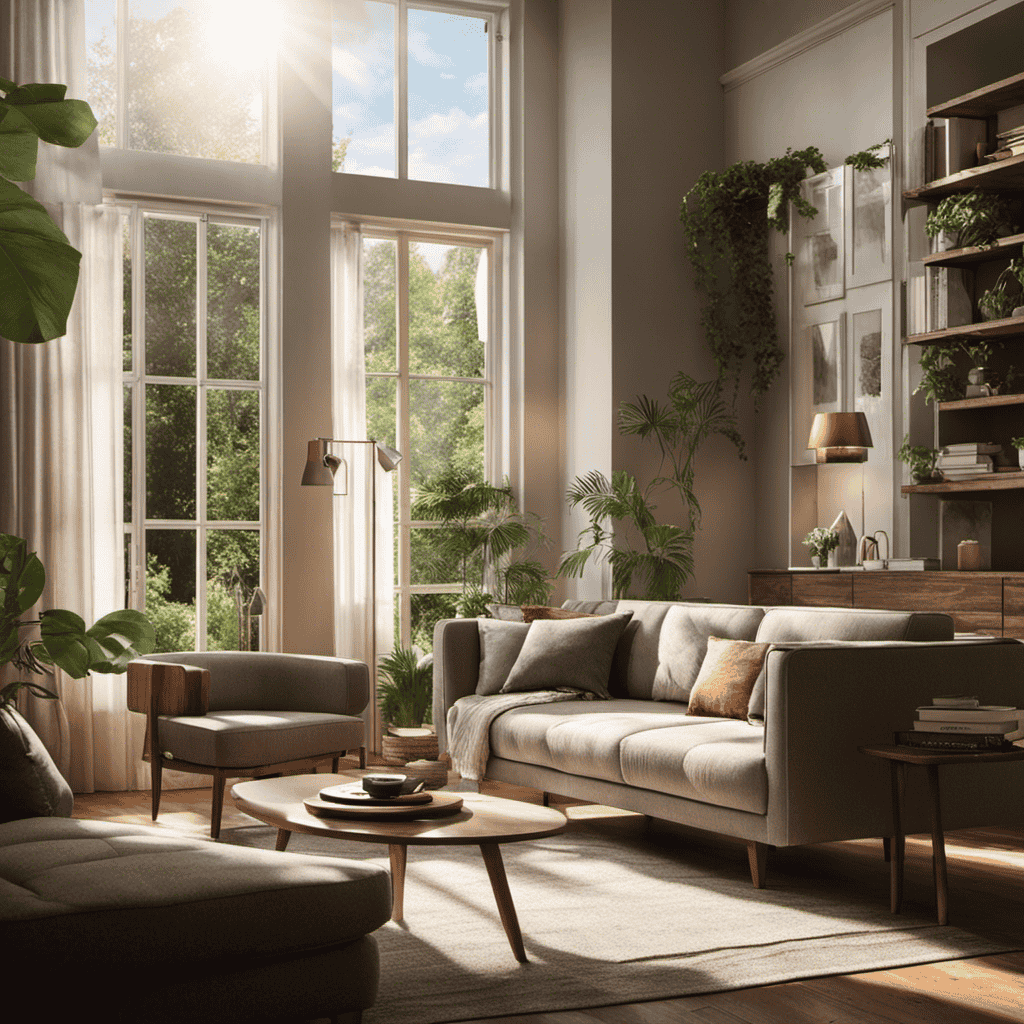As a Levoit air purifier owner, I recognize the significance of maintaining its cleanliness and optimal performance.
In this guide, I’ll walk you through the step-by-step process of cleaning your Levoit air purifier to ensure optimal performance and longevity.
From gathering the necessary supplies to reassembling and restarting the purifier, I’ll provide you with detailed instructions to make the cleaning process a breeze.
So let’s dive in and discover how to keep your Levoit air purifier in top-notch condition.
Key Takeaways
- Different cleaning methods depending on dirt and dust buildup
- Turn off and unplug the unit before cleaning
- Routine maintenance with a soft, damp cloth
- Deeper clean by removing and washing filters
Understanding the Cleaning Process
To properly clean your Levoit air purifier, you’ll need to understand the cleaning process.
There are a few different cleaning methods you can use, depending on the level of dirt and dust buildup. First, make sure the unit is turned off and unplugged before starting any cleaning.
For routine maintenance, you can simply use a soft, damp cloth to wipe down the exterior of the purifier.
However, for a deeper clean, you’ll need to remove the filters and wash them according to the manufacturer’s instructions.
Troubleshooting tips include checking for any clogs or blockages in the air vents and ensuring that the filters are properly installed.
Now that you understand the cleaning process, let’s move on to gathering the necessary supplies.
Gathering the Necessary Supplies
First, make sure you have all the supplies you need for the cleaning process. Understanding maintenance of your Levoit air purifier is crucial in keeping it functioning at its best.
To effectively clean your air purifier, you will need the following supplies:
-
Microfiber cloth: This soft cloth is perfect for gently wiping down the exterior of your air purifier, removing dust and dirt without scratching the surface.
-
Mild detergent: A mild detergent mixed with warm water is ideal for cleaning the filter and other removable parts of your air purifier. Avoid using harsh chemicals or abrasive cleaners as they may damage the components.
-
Soft-bristle brush: A soft-bristle brush is useful for gently scrubbing the filter and removing stubborn particles. Be careful not to apply too much pressure to avoid damaging the delicate filter.
With these cleaning supplies on hand, you can ensure that your Levoit air purifier remains clean and efficient, providing you with fresh and purified air.
Turning Off and Unplugging the Air Purifier
When it comes to turning off and unplugging your Levoit air purifier, it is important to follow the proper shutdown procedure to ensure the longevity and efficiency of the device.
Firstly, make sure to switch off the power button located on the control panel.
Next, unplug the air purifier from the electrical outlet by firmly grasping the plug and pulling it out.
Remember to always exercise safety precautions while unplugging, such as avoiding pulling on the cord itself and keeping your hands dry to prevent any electrical accidents.
Proper Shutdown Procedure
Make sure you follow the proper shutdown procedure for your Levoit air purifier to avoid any potential damage. Here are three important steps to follow:
-
Press the power button: Locate the power button on your air purifier and press it to turn off the device. This will ensure that the purifier stops running and is ready for shutdown.
-
Unplug the power cord: After turning off the air purifier, unplug the power cord from the electrical outlet. This step is essential for safety precautions and to prevent any accidental power surges or electrical issues.
-
Store properly: Once the air purifier is turned off and unplugged, make sure to store it in a safe and dry place. Avoid exposing the device to extreme temperatures or moisture, as this can affect its performance and lifespan.
Safety Precautions While Unplugging
Before unplugging your Levoit air purifier, be sure to take the necessary safety precautions. Electrical safety is crucial to prevent any accidents or damage to the device. Here are some precautions to follow:
-
Turn off the power: Before unplugging, make sure to turn off the power supply to the air purifier. This will prevent any electrical shocks or short circuits.
-
Unplug from the outlet: Gently pull the plug from the power outlet. Avoid yanking or pulling forcefully, as this can damage the cord or the outlet.
-
Keep away from water: Ensure that the air purifier and its cord are kept away from water sources. Water and electricity do not mix well and can cause serious hazards.
-
Store properly: After unplugging, neatly coil the cord and store it in a safe place, away from any potential damage or tripping hazards.
Removing and Cleaning the Pre-Filter
To clean your Levoit air purifier, start by unplugging it from the power source. Cleaning and maintaining your air purifier is essential for ensuring its efficient performance and longevity.
Here’s a step-by-step guide on removing and cleaning the pre-filter:
-
Locate the pre-filter: The pre-filter is usually located at the back or side of the air purifier. It acts as the first line of defense by capturing larger particles like dust and pet hair.
-
Remove the pre-filter: Gently pull out the pre-filter from its slot. Some models may have a latch or button for easy removal.
-
Clean the pre-filter: Rinse the pre-filter under running water to remove trapped particles. Use a soft brush or sponge to remove stubborn dirt. Allow the pre-filter to air dry completely before reinstalling it.
Understanding maintenance and proper filter care is crucial in keeping your Levoit air purifier in top shape. Regularly cleaning the pre-filter helps maintain its effectiveness in capturing airborne pollutants.
Cleaning the Activated Carbon Filter
When it comes to maintaining the performance of your air purifier, proper cleaning techniques and regular filter maintenance are crucial.
Cleaning the activated carbon filter requires specific steps to ensure its effectiveness in removing odors and harmful gases.
Additionally, understanding the frequency of filter cleaning will help you establish a routine that keeps your air purifier running efficiently and your indoor air quality at its best.
Proper Cleaning Techniques
Make sure you’re using a soft, damp cloth to clean the exterior of your Levoit air purifier. Understanding the importance of proper cleaning techniques will ensure that your air purifier continues to function optimally.
Here are some cleaning product recommendations to effectively clean your Levoit air purifier:
-
Levoit Air Purifier Replacement Filter: This filter is specifically designed for Levoit air purifiers and provides excellent filtration performance. It is recommended to replace the filter every 6-8 months, depending on usage.
-
Isopropyl Alcohol: To sanitize and disinfect the exterior surfaces of your air purifier, use a cloth dampened with isopropyl alcohol. This will help remove any bacteria or germs that may have accumulated.
-
Compressed Air: To remove dust and debris from the vents and other hard-to-reach areas, use compressed air. This will help maintain proper airflow and ensure the longevity of your air purifier.
Frequency of Filter Cleaning
Regularly cleaning the filter of your Levoit air purifier is essential for maintaining its effectiveness and improving the quality of the air in your home. Understanding maintenance and the importance of filter replacement is key to ensuring optimal performance. The frequency at which you should clean your air purifier’s filter depends on several factors, such as the level of air pollution in your area and the presence of pets or smokers in your home. To help you determine the ideal cleaning schedule, refer to the table below:
| Level of Air Pollution | Pets | Smokers | Cleaning Frequency |
|---|---|---|---|
| Low | No | No | Every 3-6 months |
| Moderate | Yes | No | Every 2-3 months |
| High | Yes | Yes | Every 1-2 months |
Washing or Replacing the True HEPA Filter
To maintain optimal performance, it’s important to regularly wash or replace the True HEPA filter in your Levoit air purifier. Here are three important things to know about washing techniques and filter replacement:
-
Washing Techniques: The True HEPA filter can be washed with water to remove trapped particles. Gently rinse the filter under running water until it is clean. Avoid using harsh detergents or scrubbing the filter, as this can damage its delicate fibers.
-
Filter Replacement: Over time, the True HEPA filter may become less effective at capturing airborne pollutants. It is recommended to replace the filter every 6 to 8 months, depending on usage and air quality. Levoit provides replacement filters that are specially designed to fit your air purifier model.
-
Maintenance Reminder: It’s a good practice to set a reminder to check and clean the filter regularly. This will help ensure that your Levoit air purifier continues to provide clean and fresh air for you and your family.
To properly maintain your Levoit air purifier, it’s also essential to clean the air intake vents.
Cleaning the Air Intake Vents
When it comes to cleaning the air intake vents of an air purifier, it’s important to use effective cleaning techniques to ensure optimal performance.
One effective technique is to use a soft brush or vacuum attachment to gently remove any dust or debris from the vents.
Additionally, regular maintenance tips for vents include checking for any blockages or obstructions and ensuring proper airflow for efficient operation.
Effective Cleaning Techniques
One way to effectively clean your Levoit air purifier is by using a damp cloth to wipe down the exterior. This will remove any dust or dirt that has accumulated on the surface. However, it’s important to understand the benefits of regularly cleaning your air purifier to ensure its optimal performance.
To help troubleshoot common issues, here are three additional cleaning techniques you can use:
-
Remove and clean the pre-filter: The pre-filter is designed to trap larger particles like dust and pet hair. To clean it, simply remove the pre-filter from the air purifier and rinse it under running water. Let it dry completely before reattaching it.
-
Vacuum the inner filters: Over time, the inner filters may become clogged with smaller particles. Use a vacuum cleaner with a brush attachment to gently remove any debris from the filters. Avoid using water or liquid cleaners on the inner filters.
-
Clean the air outlet grille: The air outlet grille is located at the back of the air purifier. Use a soft brush or cloth to remove any dust or dirt that may have accumulated on the grille.
Maintenance Tips for Vents
Regularly checking and changing the filters in your air vents is essential for maintaining good air quality in your home. Understanding maintenance and taking proactive steps to keep your vents clean will not only improve the air you breathe, but also prolong the lifespan of your air purifier.
To ensure optimal performance, I recommend following these maintenance tips:
- Clean or replace filters every 3-6 months, depending on usage.
- Check for any visible debris or dust buildup on the vents and clean them using a soft brush or vacuum.
- Inspect the vents for any signs of damage or blockage, and repair or remove any obstructions.
By regularly maintaining your air vents, you can prevent the buildup of allergens, pollutants, and bacteria, ensuring cleaner and healthier air in your home. This simple yet crucial step will not only improve the efficiency of your air purifier but also extend its lifespan, saving you money in the long run.
Take charge of your indoor air quality by prioritizing vent maintenance.
Wiping Down the Exterior Surfaces
To clean your Levoit air purifier, start by wiping down the exterior surfaces with a damp cloth. This will help remove any dust or dirt that may have accumulated. When wiping, it’s important to understand the proper cleaning techniques to ensure you don’t damage the unit. Here are some safety precautions to keep in mind while wiping:
- Turn off the air purifier and unplug it from the power source before cleaning to avoid any electrical accidents.
- Use a gentle, non-abrasive cloth to prevent scratching the surface of the purifier.
- Avoid using harsh chemicals or solvents as they can damage the exterior.
By following these steps, you can effectively clean the exterior of your Levoit air purifier and maintain its sleek appearance.
Now, let’s move on to cleaning the control panel and display.
Cleaning the Control Panel and Display
Make sure you turn off and unplug your air purifier before wiping the control panel and display to prevent any electrical accidents. Cleaning the control panel and display is an important step in maintaining your Levoit air purifier. To understand the cleaning process, refer to the table below for a detailed guide:
| Step | Procedure |
|---|---|
| 1 | Turn off and unplug the air purifier |
| 2 | Dampen a soft cloth with water or a mild cleaning solution |
| 3 | Gently wipe the control panel and display |
| 4 | Avoid using abrasive cleaners or excessive moisture |
| 5 | Allow the control panel and display to dry completely before plugging the air purifier back in |
While unplugging the air purifier, it is crucial to follow safety precautions to avoid any electrical accidents. Always grip the plug firmly and pull it straight out from the power outlet. Do not yank the cord or use excessive force. By following these steps and precautions, you can keep your Levoit air purifier clean and in optimal working condition.
Reassembling and Restarting the Air Purifier
After reassembling the parts, you can simply plug in the air purifier and press the power button to restart it.
Here are some reassembling tips and troubleshooting common issues to help you get your Levoit air purifier up and running smoothly again:
-
Double-check all connections: Ensure that all the parts, such as the filters and panels, are securely fitted into their respective slots. Any loose connections can affect the performance of the air purifier.
-
Clean the filters: Before reassembling, make sure you have thoroughly cleaned the filters according to the manufacturer’s instructions. Dirty filters can hinder the airflow and reduce the effectiveness of the air purifier.
-
Reset the settings: If you encounter any issues after reassembling, try resetting the air purifier to its default settings. This can often resolve common operational problems.
Maintaining Regular Cleaning Schedule
After reassembling and restarting my Levoit air purifier, I have learned the importance of maintaining a regular cleaning schedule. Understanding the benefits of regular cleaning is essential for ensuring optimal performance and longevity of the air purifier.
By regularly cleaning the filters and the exterior of the device, I can effectively remove dust, pollen, pet dander, and other airborne particles that may accumulate over time. This not only improves the air quality in my home but also helps to extend the lifespan of the filters.
However, there may be some common issues that can arise during the cleaning process, such as difficulty removing the filters or encountering a strange odor. Troubleshooting these issues can be easily resolved by referring to the user manual or contacting Levoit customer support for assistance.
Frequently Asked Questions
Can I Clean the Levoit Air Purifier Without Turning It off and Unplugging It?
No, it is not recommended to clean the Levoit Air Purifier without turning it off and unplugging it. This ensures your safety and prevents any damage to the purifier during the cleaning process.
How Often Should I Clean the Pre-Filter?
I clean the pre-filter of my Levoit air purifier every three months to maintain its effectiveness. To remove and replace the pre-filter, I follow the manufacturer’s instructions, ensuring a thorough cleaning process.
Can I Wash the True HEPA Filter Instead of Replacing It?
Yes, you can wash the True HEPA filter of your Levoit Air Purifier. However, it is recommended to replace the filter occasionally to ensure optimal performance and to enjoy the full benefits of clean air.
How Do I Clean the Air Intake Vents Properly?
To properly clean the air intake vents of my Levoit Air Purifier, I follow the cleaning tips and maintenance guide provided. It ensures thorough removal of dust and debris, allowing the purifier to function efficiently.
Is It Necessary to Clean the Control Panel and Display Regularly?
Cleaning the control panel and display regularly is important for proper maintenance of the Levoit Air Purifier. It ensures optimal performance and extends the lifespan of the device. Here are some cleaning tips to keep it in top condition.
What is the Best Way to Clean a Levoit Air Purifier to Ensure Proper Functioning?
The best way to maintain proper functioning of your Levoit air purifier is by regularly cleaning the Levoit air purifier filter. Gently remove the filter from the unit and vacuum off any visible debris. For a deeper clean, use a soft brush to dislodge any trapped particles. Reinsert the filter once clean.
Conclusion
So there you have it, folks! Cleaning your Levoit air purifier is a simple process that can greatly improve the air quality in your home. By following the steps outlined in this article, you can ensure that your air purifier is functioning at its best and providing you with clean, fresh air.
Remember to gather the necessary supplies, turn off and unplug the purifier, clean the pre-filter and activated carbon filter, wipe down the exterior surfaces, clean the control panel and display, and reassemble and restart the purifier.
And don’t forget to maintain a regular cleaning schedule to keep your air purifier in top condition. Happy cleaning!










